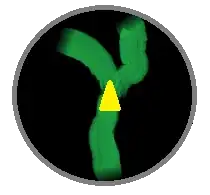So, thermodynamically the walls are extremely cold within hyperspace.
As ships use reaction drives, they'll spew out hot particles. Those particles will raise the average temperature of the tunnels.
So you just have to "thrust" both forwards and backwards, and ensure that the wave of hot particles in front of you goes out far enough. Then you measure how far the hot particles in front of you reach, and that tells you if you are approaching a wall.
The "forward thrust" is going to be a different kind of rocket, as you'll want it to be reasonably "wide" stream of particles (so you can see more), and (as you don't actually want to stop) you'll compensate with (narrower) thrust behind.
This is going to be a lot like feeling your way around in the ocean by using bottom-sensing radar. You'll probably prefer to have maps and buoys for faster travel. The buoys can be made out of radar-reflective materials and have lights and even emit radio waves. Something like RFID, where they broadcast (or reflect) their identity when hit with sensors could also be good.
Your maps would then have the buoys and known "walls" on them. You'd triangulate your position (maybe even in a GPS-like way) to figure out where you are, and only have to rely on "hot gas" radar in limited situations.
Military buoys would exist that would not be reflective, and would only respond to specific cryptographic signals with cryptographic (and possibly tight-beam) responses.
Moving buoys would be a way to engage in piracy; make someone not realize where a wall is, and have them drift into it. Then jump them in normal space before they can get out.
As well as the buoys, you'll want to have relay stations for communication purposes. These stations would communicate using tight-beam to the next station.
Post offices, stations with ships in them in hyperspace, would exist that would allow you to send messages back to normal space.
As sending a ship back and forth through hyperspace transition requires certain limitations on ship design, there are going to be hyperspace-only ships that are more efficient. Similarly, you'll have specialized ships that exist only to ferry supplies over the hyperspace barrier. Some post offices could develop into railheads, with specialized hyperspace cargo carriers moving goods to the destination along well navigated routes.
Hyperspace fleet carriers which again never leave hyperspace (except in extreme situations) that deploy spaceship attack craft would be one kind of military solution. There is no stealth in normal space, and there is no practical defence; in hyperspace, the walls are cover, so you can keep your capital assets "over the horizon" (behind a twist in a hypertunnel).
I will assume hyperspace is hyperbolic, and the tunnels are local 3 space 1 time but are embedded in a 4+ space dimensional brane with positive curvature. This means that instead of n^3 volume at n distance, you get more than that; space is a saddle. This also means that attempting to form a ring of warning stations gets crazy exoensive.
Imagine if a typical tunnel goes 1 km before forking into two. Then from any one point within 10 km there are 1000 tunnels; within 20 km 1 million, within 30 km 1 billion, within 40 km 1 trillion, and it keeps going. Building early warning along all paths becomes insanely expensive; and even exploring them all is impractical.
Simply scale the branching rate to whatever level you want to make the radius of practical defence be however far you like. The average curvature of the hyoer tunnels puts a limit on hyperspace travel speed (together with engine tech limits) and how far you can see. The branching frequency as a function of travel speed and time between systems lets you know if multiple systems can form a single defensive ring, which puts geographic pressure on government sizes.

